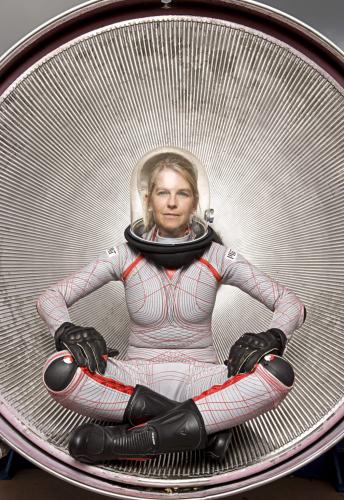
BioSuitTM, Inventor, Science and Engineering, Professor Dava Newman, MIT, Design, Guillermo Trotti, A.I.A., Trotti and Associates, Inc. (Cambridge, MA), Fabrication, Dainese (Vicenza, Italy), Photography, Douglas Sonders, Courtesy Professor Dava Newman and Guillermo Trotti.
By Diana Turnbow, administrative assistant for the Smithsonian American Women’s History Initiative
The Smithsonian Arts and Industries Building is the location for FUTURES, an exhibition that celebrates the Smithsonian’s 175th anniversary. As America’s first museum on the National Mall, the Arts and Industries Building has been an incubator for new ideas since it opened in 1881. Crossing its threshold is a kind of time travel: back to the early years of the Smithsonian, and ahead to the future.
FUTURES combines technology, art, design, and history. The exhibition demonstrates that everyone can be a part of a more hopeful, sustainable, and inclusive world. FUTURES is on view for one more month, closing July 6, 2022.
“The future is not a fact but a series of decisions we make every day,” said Monica Montgomery, social justice, special projects, and program curator for the museum. “We all have the power to shape it.”
Here are five women whose creativity and innovation are energizing the future:
1. Artist Soo Sunny Park

Photo of Soo Sunny Park by Eli Burak, 2021. Courtesy of Soo Sunny Park.
Borders or boundaries are important metaphors for sculpture and installation artist Soo Sunny Park, who came to the United States from South Korea at age ten. Park creates pieces that highlight transitional or “in-between” spaces.
She explains “I hope to provoke the sense of the physical world and an imagined world coming together, present as one. I hope that this gives people a moment to stop and think about the way we divide our world and the ways in which we might do that differently.”
Park created “Expanded Present” to span the doorway of the historic Smithsonian Arts and Industries Building into the FUTURES exhibition. The installation focuses on the present moment as an ever-changing space between the past and the future.
Using dichroic acrylic, a material invented by NASA, “Expanded Present” reacts to changing light conditions. As the seasons and time of day change, the installation’s colors change. Each moment is like a visual time stamp: a unique impression of color and pattern.
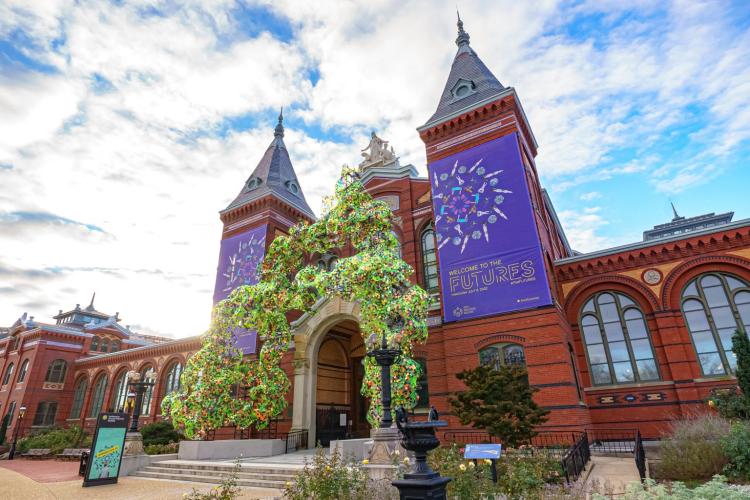
“Expanded Present” by Soo Sunny Park at the Smithsonian Arts and Industries Building, 2021. Photo courtesy Albert Ting.
2. Science Fiction Writer Octavia Butler
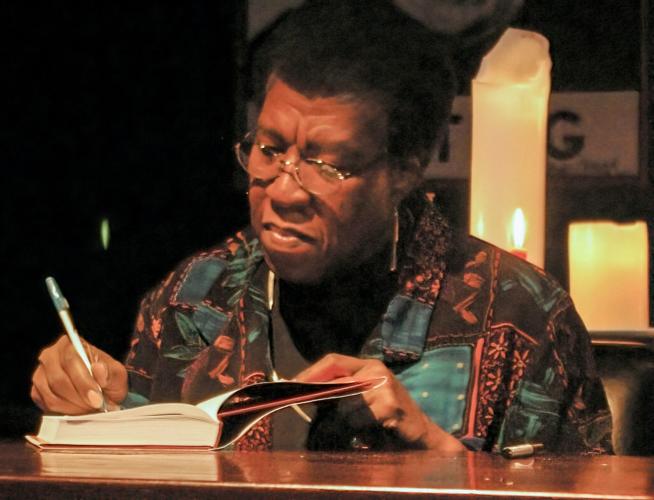
Octavia E. Butler signing a copy of her book Fledgling after speaking on a book tour in October 2005. Photo courtesy of Nikolas Coukouma and Wikimedia Commons.
At the age of 12, Octavia E. Butler watched a sci-fi movie and realized that she could write a better story. Her conviction carried Butler through school and years of balancing temporary jobs while writing. Butler’s dyslexia also informed her writing.
Butler centered her novels on Black women who navigate dystopian worlds plagued by disease, climate change, and racial inequality. These characters take charge of their own destiny as they work to build a better future. Butler’s writing shaped the genre of Afrofuturism, which explores positive potential outcomes for people of the African diaspora—who have cultural identities created away from their homeland—through science fiction, alternate history, and fantasy.
Butler demonstrated that science fiction is not a niche genre. Her novels such as Kindred, from 1979, and The Parable of the Sower, from 1995, are now taught in high school and university classes. She won several Nebula and Hugo awards for excellence in science fiction. She was also the first science fiction writer to receive a MacArthur Fellowship in 1995. After her death in 2006, her novels continue to inform culture. An opera inspired by The Parable of the Sower debuted in 2018. Televised versions of her novels Dawn and Wild Seed are currently in production.
Butler’s typewriter, from the collection of the Anacostia Community Museum, is featured in FUTURES.

Olivetti Studio 46 Typewriter Used by Octavia Butler between 1974 and 1979. Anacostia Community Museum.
3. Vaccine Researcher Dr. Kizzmekia Corbett

Photograph of Dr. Kizzmekia Corbett. Courtesy of Kizzmekia Corbett and Wikimedia Commons.
FUTURES highlights the remarkable speed and innovation that led to the development of vaccines to combat COVID-19. Dr. Kizzmekia Corbett is one of the many scientists across the world who worked to design the COVID-19 vaccines in early 2020. As a viral immunologist, Corbett studies how viruses evolve to become diseases in humans. Corbett then designs vaccines that stimulate a safe and effective immune response to the virus.
Corbett discovered her passion for science research during a summer internship in high school. She studied biological sciences and sociology in college, earning a Ph.D. in Microbiology and Immunology from the University of North Carolina at Chapel Hill in 2014. That same year, Corbett became a research fellow at the National Institutes for Health (NIH). Her lab at the NIH collaborated with the biotech firm Moderna to develop an innovative application of mRNA technology in a vaccine.
Since this breakthrough, she has worked to build public confidence in the safety and effectiveness of the vaccines.
4. Scholar and Artist Beatriz Cortez
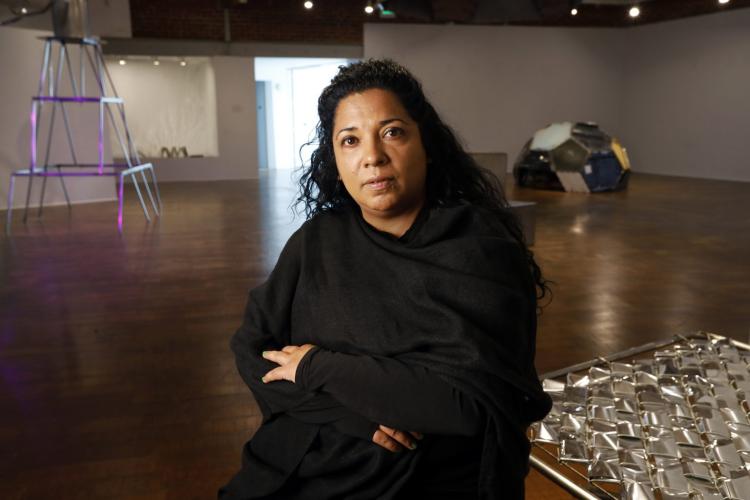
Photograph of Dr. Kizzmekia Corbett. Courtesy of Kizzmekia Corbett and Wikimedia Commons.
Beatriz Cortez studied studio art in her native El Salvador, before she immigrated to the United States in 1989, seeking refuge from the Salvadoran Civil War. After earning a PhD in Latin American literature and while teaching at California State University, Northridge, Cortez returned to art. Her knowledge of Central American history and culture inspires her large sculptural installations.
Beatriz Cortez’s installation in FUTURES references ancient Mayan practices for the storage of seeds, water, and other natural and spiritual resources. Mayans stored resources in large spaces they carved into stone foundations underground. Hundreds of these structures or storage vaults, known as chultunes, have survived in the Yucatan peninsula. Cortez has reimagined these structures as time machines: space capsules made of steel. Her space capsules allow for the preservation of life on earth, in all its forms.
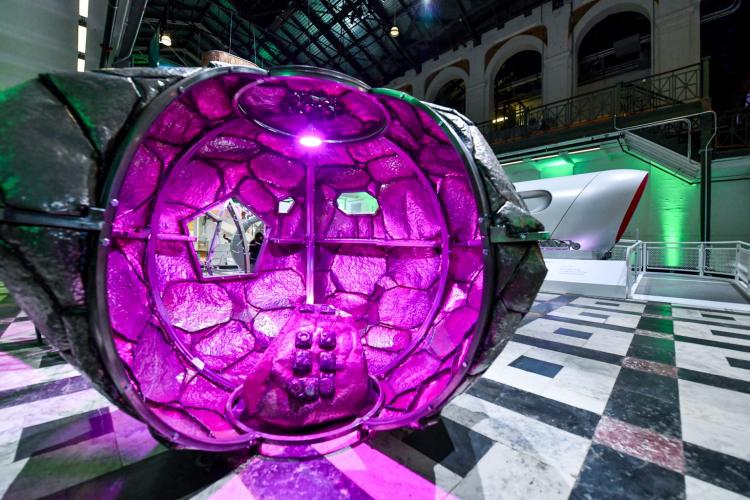
Beatriz Cortez, Chultun El Semillero, 2021, detailed view at Smithsonian Arts and Industries Building. Courtesy FotoBriceno.
5. Engineer and Scientist Dava Newman

BioSuitTM, Inventor, Science and Engineering, Professor Dava Newman, MIT, Design, Guillermo Trotti, A.I.A., Trotti and Associates, Inc. (Cambridge, MA), Fabrication, Dainese (Vicenza, Italy), Photography, Douglas Sonders, Courtesy Professor Dava Newman and Guillermo Trotti.
Dava Newman is an aerospace biomedical engineer who researches how humans can move more effectively in zero or reduced gravity environments in space. Current spacesuits are very similar to those worn by all-male astronauts 50 years ago. They are heavy and bulky, making it difficult to perform work in space.
Newman worked with colleagues at NASA, MIT, and industry partners to develop a new kind of spacesuit. The BioSuitTM they developed features form-fitting elastic polymers and other advanced materials. These materials not only provide the pressure required to protect the human body, but also permit a full range of motion. Notably, they fit a wider range of users, including women.
Newman’s new technologies solve problems here on earth as well. She is adapting the technology used in the BioSuitTM to help children who have cerebral palsy and people who have lost motor skills due to strokes.
See more innovative women and their work in FUTURES online or in person through July 6, 2022.
Related Posts
Diana Turnbow provides administrative support and works on special projects for the American Women’s History Initiative. She is invested in finding and sharing the stories of American women artists and makers.